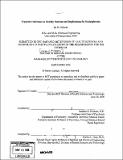Transitive inference in healthy humans and implications for schizophrenia
Author(s)
Zalesak, M. (Martin)
DownloadFull printable version (23.21Mb)
Alternative title
TI in healthy humans and implications for SZ
Other Contributors
Harvard University--MIT Division of Health Sciences and Technology.
Advisor
Stephan H. Heckers.
Terms of use
Metadata
Show full item recordAbstract
Transitive inference (TI) refers to inferences on relations between items based on other known relations of those items. Using a paradigm where participants first learn a series of four overlapping pairs that constitute the ordered sequence A>B>C>D>E and are then tested on the novel TI pair BD and non-TI pair AE, animal experiments demonstrated that intact function of the hippocampus is necessary for TI but not for non-TI. We performed three functional magnetic resonance imaging (fMRI) experiments to identify neural correlates of TI in healthy humans. First, we show hippocampal activation in learning overlapping pairs that constitute an ordered sequence but not non-overlapping individual pairs. Second, we demonstrate hippocampal recruitment in inferences on the ordered sequence of overlapping pairs (TI) but not on non-overlapping pairs (non-TI, e.g., if a>b and c>d then a>d). We then demonstrate the specificity of hippocampal activation to TI on pairs that are devoid of sequence end-items (e.g., B>D vs. A>C). The results support the relational flexibility account of hippocampal function. (cont.) Under this account, the hippocampus plays a special role in declarative memory in that it acts to rapidly bind common features into a unified representation that supports flexible inferential memory expression. Other brain areas that were activated in TI included prefrontal cortex, pre-supplementary and supplementary motor areas, insula, anterior and posterior cingulate cortex, lateral temporal cortex, precuneus, posterior parietal cortex, cerebellum, thalamus, ventral striatum and midbrain (the TI network). In schizophrenia, TI performance is impaired. Could this deficit be linked to hippocampal abnormalities in SZ? We used the findings from studies of TI in healthy participants to interpret an fMRI study of TI in SZ. In SZ, we confirmed the deficit in TI on pairs devoid of end-items (e.g., B>D) but not on pairs including an end-item (e.g., A>C) and linked it to reduced hippocampal activation. Further, we uncovered aberrant function in two points of the TI network - anterior cingulate and inferior parietal cortices - in SZ.
Description
Thesis (Ph. D.)--Harvard-MIT Division of Health Sciences and Technology, 2006. "September 2006." Includes bibliographical references.
Date issued
2006Department
Harvard University--MIT Division of Health Sciences and TechnologyPublisher
Massachusetts Institute of Technology
Keywords
Harvard University--MIT Division of Health Sciences and Technology.